GOGO
Member
- Joined
- Jul 16, 2013
- Messages
- 36
I had stored a bunch of PSX CD images on my 32GB SD card. It's the left slot from where I'm booting the OS too. After about six month I felt the need to fire up some of my PSX games using PCSX ReARMed r19, as I did in the past.
But stangely I got glitches with gfx and sound I never had before. PCSX ReARMed even crashed. I deleted the appdata of PCSX ReARMed r19 to eliminate potentially wrong settings, downloaded the PND again - but no luck.
The time I created the game disc images I also created a .md5 file for every image. So next step I copied the images over to the other sd card in the right slot and was informed about read errors by Thunar File Manager two or three times. I tried Midnightcommander - I got read errors at the same files and points at the progress bar. But most files where copied without any error message.
Then I put the right SD card with the game disc images in my windows netbook and was checking the integrity of every image and volia: nearly every image has a CRC mismatch, not just the images where I saw the read error message but nearly all images that were copied just fine.
I did a quick search via google (board) and the wiki but no luck. So the two questions are:
1. Are there known issues with files getting corrupted over time if stored on the same card as booting the OS from for some reason? Or maybe other known issues regarding big files getting corrupted on Pandora?
2. Is there a tool that allows me to create and verify md5 check sums on pandora comfortably? At the moment I have to check the md5 using a windows application (named QickSFV). It's computing the check sum of every selected file and create a file with all the file names and check sums. If you want to verify, click on the .md5 file to have the application opening and checking all the files. I did look at the repo but again without luck.
Any advice is appreciated. Thank you.
PS: I have a 1Ghz with SZ 1.55, kernel 3.2 installed on sd card
edit: worst typos eliminated
But stangely I got glitches with gfx and sound I never had before. PCSX ReARMed even crashed. I deleted the appdata of PCSX ReARMed r19 to eliminate potentially wrong settings, downloaded the PND again - but no luck.
The time I created the game disc images I also created a .md5 file for every image. So next step I copied the images over to the other sd card in the right slot and was informed about read errors by Thunar File Manager two or three times. I tried Midnightcommander - I got read errors at the same files and points at the progress bar. But most files where copied without any error message.
Then I put the right SD card with the game disc images in my windows netbook and was checking the integrity of every image and volia: nearly every image has a CRC mismatch, not just the images where I saw the read error message but nearly all images that were copied just fine.
I did a quick search via google (board) and the wiki but no luck. So the two questions are:
1. Are there known issues with files getting corrupted over time if stored on the same card as booting the OS from for some reason? Or maybe other known issues regarding big files getting corrupted on Pandora?
2. Is there a tool that allows me to create and verify md5 check sums on pandora comfortably? At the moment I have to check the md5 using a windows application (named QickSFV). It's computing the check sum of every selected file and create a file with all the file names and check sums. If you want to verify, click on the .md5 file to have the application opening and checking all the files. I did look at the repo but again without luck.
Any advice is appreciated. Thank you.
PS: I have a 1Ghz with SZ 1.55, kernel 3.2 installed on sd card
edit: worst typos eliminated
Last edited by a moderator:


